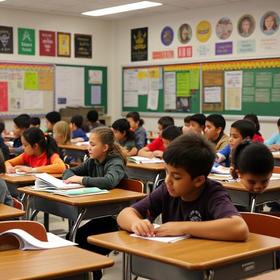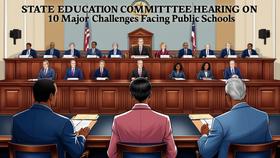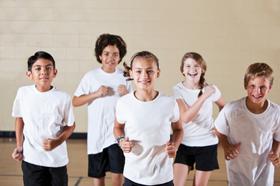Serving 74 students in grades 5-12, Julian E. Blanco - Ballet ranks in the top 50% of all schools in Puerto Rico for overall test scores (math proficiency is bottom 50%, and reading proficiency is bottom 50%).
The percentage of students achieving proficiency in math is ≤10% (which is lower than the Puerto Rico state average of 23%). The percentage of students achieving proficiency in reading/language arts is 60-69% (which is higher than the Puerto Rico state average of 36%).
The student-teacher ratio of 4:1 is lower than the Puerto Rico state level of 10:1.
Quick Facts (2025-26)
- Grades: 5-12
- Enrollment: 74 students
- Student-Teacher Ratio: 4:1
- Graduation Rate: ≥50%
- Overall Testing Rank: Top 50% in PR
- Math Proficiency: ≤10% (Btm 50%)
- Reading Proficiency: 60-69% (Top 10%)
- Science Proficiency: 60-79% (Top 20%)
- Source: National Center for Education Statistics (NCES), PR Dept. of Education
Top Rankings
Julian E. Blanco - Ballet ranks among the top 20% of public schools in Puerto Rico for:
Category
Attribute
Reading/Language Arts Proficiency
Science Proficiency
Percent Eligible For Free Lunch
Community Size
Student Attention
School Overview
Julian E. Blanco - Ballet's student population of 74 students has declined by 30% over five school years.
The teacher population of 18 teachers has declined by 5% over five school years.
Grades Offered
Grades 5-12
(No virtual instruction)
(No virtual instruction)
Total Students
74 students
Gender %
Total Classroom Teachers
18 teachers
School Rankings
Julian E. Blanco - Ballet ranks within the top 50% of all 839 schools in Puerto Rico (based off of combined math and reading proficiency testing data).
The diversity score of Julian E. Blanco - Ballet is 0.00, which is less than the diversity score at state average of 0.01. The school's diversity has stayed relatively flat over five school years.
Overall Testing Rank
#279 out of 839 schools
(Top 50%)
(Top 50%)
Math Test Scores (% Proficient)
≤10%
23%
Reading/Language Arts Test Scores (% Proficient)
60-69%
36%
Science Test Scores (% Proficient)
60-79%
36%
Student-Teacher Ratio
4:1
10:1
American Indian
n/a
n/a
Asian
n/a
n/a
Hispanic
100%
100%
Black
n/a
n/a
White
n/a
n/a
Hawaiian
n/a
n/a
Two or more races
n/a
n/a
All Ethnic Groups
Graduation Rate
(21-22)≥50%
74%
Participates in the National School Lunch Program (NSLP)
Yes
Eligible for Free Lunch
84%
85%
Eligible for Reduced Lunch
7%
6%
School Statewide Testing
School District Name
Source: National Center for Education Statistics (NCES), PR Dept. of Education
Profile last updated: 02/09/2025
Frequently Asked Questions
What is Julian E. Blanco - Ballet's ranking?
Julian E. Blanco - Ballet is ranked #279 out of 839 schools, which ranks it among the top 50% of public schools in Puerto Rico.
What percent of students have achieved state testing proficiency in math and reading?
≤10% of students have achieved math proficiency (compared to the 23% PR state average), while 60-69% of students have achieved reading proficiency (compared to the 36% PR state average).
What is the graduation rate of Julian E. Blanco - Ballet?
The graduation rate of Julian E. Blanco - Ballet is 50%, which is lower than the Puerto Rico state average of 74%.
How many students attend Julian E. Blanco - Ballet?
74 students attend Julian E. Blanco - Ballet.
What is the racial composition of the student body?
100% of Julian E. Blanco - Ballet students are Hispanic.
What is the student-teacher ratio of Julian E. Blanco - Ballet?
Julian E. Blanco - Ballet has a student ration of 4:1, which is lower than the Puerto Rico state average of 10:1.
What grades does Julian E. Blanco - Ballet offer ?
Julian E. Blanco - Ballet offers enrollment in grades 5-12 (No virtual instruction).
What school district is Julian E. Blanco - Ballet part of?
Julian E. Blanco - Ballet is part of Puerto Rico Department Of Education School District.
School Reviews
5 10/10/2025
Great education and compromise for the art of Ballet and academics.
Review Julian E. Blanco - Ballet. Reviews should be a few sentences in length. Please include any comments on:
- Quality of academic programs, teachers, and facilities
- Availability of music, art, sports and other extracurricular activities
Recent Articles

How Public Schools Support Students on Free / Reduced-Lunch Programs
Explore how U.S. public schools support students eligible for free or reduced-price lunch through nutrition, academic, and wraparound services in 2025.

Hidden Costs of Public Schools: Fees, Supplies & Extras
Explore the hidden costs in public schools鈥攆ees, supplies, extracurriculars鈥攁nd how parents can plan for them in 2025.

Public School Funding 2025: What Families Should Know
Essential insights on public school funding in 2025鈥攈ow it works, what鈥檚 changing, and what families should know to stay ahead.





